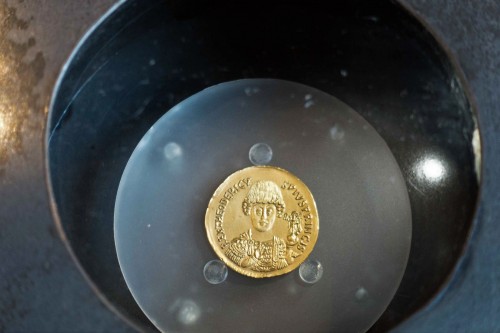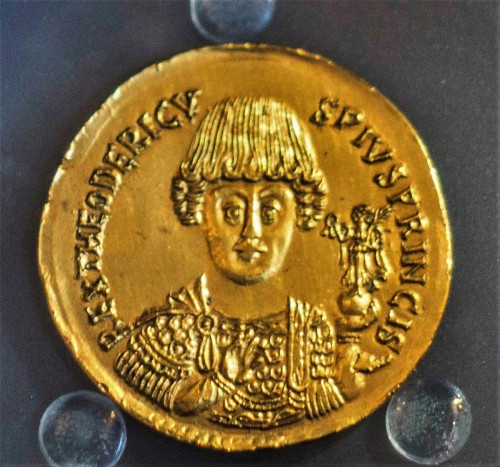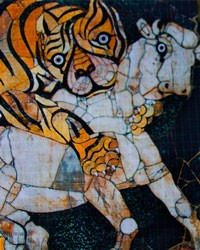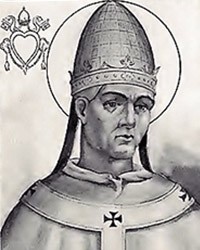Even more so because those who were in the know, were conscious of the fact that they had just witnessed a shrewd political maneuver conducted above their heads. When in the year 487 the armies of Theodoric, leader of the Eastern Goths (Ostrogoths), found themselves outside the walls of Constantinople, Emperor Zeno – irritated by their constant invasions onto the lands of his empire – conceived a cunning plan. He decided to turn an enemy, which for him was the young, ambitious leader from the Amali dynasty, into a strategic tool. He knew him well, since as was the habit, Theodoric had spent ten years of his life in Constantinople (approx. 459-469) as a sort of guarantee of peace between the emperor and his uncle – the duke of Ostrogoths Valamir. He became familiar with the habits and language of the Romans and despite attempted indoctrination he did not become a fan of the Emperor of the East, at least in the longer perspective. When upon his return from Constantinople he assumed the throne of the united Ostrogoths in the year 484, from time to time he cooperated with the emperor. However, there were constant conflicts, mainly due to overdue soldier’s pay and it was a pretext to attack Zeno and stand at the walls of Constantinople. During peace negotiations, which were the consequence of all this, the emperor granted Theodoric the prestigious title of consul and “pushed” him west, to Italy. The shrewd Zeno in this way removed the Ostrogoth threat and the 20 thousand women and children following it, searching for land and a place to live, while also allowing Odoacer to be overthrown, in a way sacrificing him on the altar of his own interests.
The several-years-long battles between Roman armies defending Odoacer and the armies of Theodoric ended with an armistice and the promise of the Amal that from then on they would rule jointly, after which Theodoric himself killed his rival and ordered his family to be executed. Soon afterwards he became the king of Italy not even waiting for consent of the Emperor of the East, whose mantle in the meantime had been assumed by Anastasius, after Zeno’s death. The emperor could only accept the state of affairs in place. However, he did something more: he sent Theodoric, the imperial insignia of the Western Empire, which Odoacer had returned in the past, thus sanctioning his position. In the long run Theodoric had hoped for a rebirth of the former Western Empire. He acted like an emperor, while his court in Ravenna was similar to that of the last emperors, he even had coins minted, on which although he appeared without a diadem he did have a halo of carefully modeled curls with a figure of Victory in his hand. The inscription on them read “Flavius Theodericus rex”.
The inhabitants of Italy and Rome could breathe a sigh of relief. The new king listened to their voices and changed nothing in the management of the state structure already in place. The senators were treated with the proper dignity, the representatives of the Church with respect and the fact that Theodoric, similarly to Odoacer was an Arian (Arianism), did not present a problem either. In time Rome became more reminiscent of a provincial town rather than the heart of the empire that it had once been. Within a century, hundreds of thousands of inhabitants left, so that at the time its population was roughly 100 thousand. Some districts fell into ruin, the forums were deserted, yet they were still filled with the statues of former emperors, while ancient structures, although neglected, still recalled former times of glory. In the city, pilgrims were more and more visible, coming to the sanctuaries of the two most important apostles (saints Peter and Paul), among the old, shut down temples of pagan gods, hospices and shelters for pilgrims appeared, as well as monasteries. The city was transformed from a metropolis of pagan culture into a holy city, elevated by its two great martyrs.
Theodoric first came to Rome in the year 500. The representatives of the authorities of the city and the Church as well as senators welcomed him with respect and honor. He himself, prior to going to Palatine Hill – the residence of the former emperors, arrived at St. Peter’s Basilica on the Vatican (San Pietro in Vaticano) and fell to his knees at the apostle’s tomb. Only after he came to the Senate, where he delivered a speech in broken Latin, letting the people of the city as well as all of Italy know, that they could feel safe under his reign. Reportedly Theodoric was not a good orator, he could not write inn Latin, while speaking the language was also not his strong suit, so it can be assumed that somebody did it on his behalf. He also declared, most likely at the request of the Romans themselves aid in maintaining the deteriorating buildings. He appointed a body to watch over city property, which at that time more and more often was looted of thieves and robbers and he employed an architect who was tasked with renovating canals, aqueducts, baths, and city walls and preventing the imperial palace on Palatine Hill from falling into ruin, as well as saving monuments from imperial times. Due to Theodoric’s arrival equestrian events, which were sponsored by him and which still enjoyed a great popularity among Romans, were inaugurated in the local hippodrome (Circus Maximus). Theodoric also brought back the imperial tradition of giving out grain to the poor and medals with his image to the rich. Coming to the city, he generously gave out gifts, therefore, it should come as no surprise that some inhabitants saw in him a true August, a successor to the emperors. This is further testified to by columns with the image of the king, which the Senate funded in his honor.
The leader of the Goths spent six months in the city on the Tiber and also did not forget about the churches. At his initiative the Church of Santa Croce was renovated, as well as the Church of San Giovanni in Porta Latina. At the end of his life he issued the newly elected Pope Felix IV a concession to build a new church on the Forum Romanum – Santi Cosma e Damiano.
Good relations with Rome and Romans were strained when, the schism between the Eastern and Western Churches came to an end. This was a consequence of an edict issued by the successor of Anastasius – Emperor Justinian I, in which he forbade Arianism and ordered all property in the possession of the Arians to be handed over to the Catholic clergy. This was an attack on Theodoric himself (an Arian), at least that is how it was understood by the king of Italy. In the Roman Senate as well as among they clergy, allies of the emperor appeared counting on removing the barbarian ruler from power. What, had for decades, never before constituted a problem, since the coexistence between Catholics and Arians was model, could have become a spark that started a religious conflict. After 33 years of peaceful and calm reign, Theodoric had no intention of adhering to the edict. However, in order to make the best of a bad situation, he sent Pope John to Constantinople with a strange, today we would have said ecumenical mission. He was to intercede on behalf of the Arians and encourage the emperor to stop their persecutions in the Eastern Empire. However, this mission did not bring about the result desired by Theodoric and then the king’s rage fell on the emissary who was suspected of not following through on his mission. Upon his return to Italy, the pope was thrown into prison, where he soon died. Other victims included the respected senator Symmachus and his son-in-law Boethius, who – accused of treason - were ultimately executed at Theodoric’s order. Perhaps the reason for Theodoric’s discontent was not only religious, meaning defense of his own beliefs, but something equally important – the lack of acceptance by the emperor of the East for the succession of his only heir – Athalaric.
Theodoric died an old man, anointing his ten-year old grandson as his successor. He was buried in Ravenna, in a mausoleum which he himself had built. However, the Ostrogoths were unable to keep hold of the throne when the following emperor of the East, Justinian I, decided to stake his claim to Italy and Rome.
Despite his final, less than glorious deeds, the long and stable reign of Theodoric is considered by historians to be beneficial for Italy. It is even said that the Western Empire informally continued under his reign.
And one more reflection to end. The term “Gothic” which is known to us today came about in Italy to describe a style barbaric in its nature (the style of Goths). However, it is often forgotten that one of them, Theodoric, gave splendor not only to Ravenna with outstanding buildings, but also contributed to saving ancient Rome from ruin, restoring and securing its deteriorating buildings.












